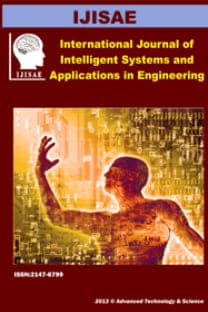MLP and KNN Algorithm Model Applications for Determining the Operating Frequency of A-Shaped Patch Antennas
___
[1] K. Wong (2002). Compact and broadband microstrip antennas. John Wiley & Sons, Inc.[2] G. Kumar and K. P. Ray (2003). Broadband microstrip antennas, Norwood: Artech House.
[3] W. F. Richards, Y. T. Lo and D. D. Harrisson (1981). An improved theory for microstrip antennas and applications. IEEE T. Antenna Propagation. 29 38─46.
[4] K. Bhattacharyya and R. Garg (1985). A generalized transmission line model for microstrip patches. IEE PROCH.13293─98.
[5] D. B. Davidson (2005). Computational electromagnetics for RF and microwave engineering, Cambridge University Press, Cambridge, United Kingdom . [6] A. Taflove (1995). Computational electrodynamics: The finite-difference time domain method, Artech House, Boston.
[7] R. F. Harrington (1993). Field computation by moment methods. Piscataway, NJ, IEEE Press.
[8] J. Singh, G. Singh, S. Kaur and B.S. Sohi (2015). Performance analysis of different neural network models for parameters estimation of coaxial fed 2.4 GHz E-shaped Microstrip patch antenna. In Recent Advances in Engineering & Computational Sciences (RAECS), 2nd International Conference on. IEEE. 1─5.
[9] N. Gunavathi and D. Sriramkumar (2015). Analysis and synthesis of coplanar waveguide-feed using Multilayer Perceptron Feed Forward Neural Networks. Signal Processing, Communication and Networking (ICSCN), 3rd International Conference on. IEEE.
[10] A. Ashrf, M. Simsek and Z. Aydin (2015). Development of knowledge based response correction for a reconfigurable N-shaped microstrip antenna design. Numerical Electromagnetic and Multiphysics Modeling and Optimization (NEMO), 2015 IEEE MTT-S International Conference on. IEEE.
[11] J. Jingon (2016). Machine Learning-Based Antenna Selection in Wireless Communications. IEEE Communications Letters. 20 (11) 2241─2244.
[12] HyperLynx® 3D EM, Version 15, Mentor Graphics Corporation, 8005 SW Boeckman Road, Wilsonville, OR 97070.
[13] M. Hall, E. Frank, G. Holmes, B. Pfahringer, P. Reutemann and I. H. Witten (2009). The WEKA Data Mining Software: An Update. SIGKDD Explorations. 11 (1) 10─18.
[14] R. Arora (2012). Comparative analysis of classification algorithms on different datasets using WEKA. International Journal of Computer Applications. 54 (13).
[15] V. Mai, I. Khalil and C. Meli (2011). ECG biometric using multilayer perceptron and radial basis function neural networks. Engineering in Medicine and Biology Society, EMBC, Annual International Conference of the IEEE.
[16] M. Kantardzic (2003). Data Mining: Concepts, Models, Methods, and Algorithms. John Wiley & Sons Publishing.
[17] J. Wang, P. Neskovic and L. N. Cooper (2007). Improving nearest neighbor rule with a simple adaptive distance measure. Pattern Recognition Letters. 28 (2) 207─213.
[18] Y. Zhou, Y. Li and S. Xia (2009). An improved KNN text classification algorithm based on clustering. Journal of computers. 4 (3) 230─237.
- ISSN: 2147-6799
- Yayın Aralığı: 4
- Başlangıç: 2013
- Yayıncı: Ismail SARITAS
Simple and Novel Approach for Image Representation with Application to Face Recognition
Use of NLP Techniques for an Enhanced Mobile Personal Assistant: The Case of Turkish
Gokhan CELİKKAYA, GÜLŞEN ERYİĞİT
COTTAPP: An Online University Timetable Application based on a Goal Programming Model
Tuğçe DURSUN, Yasemin SÜ, Rana COŞGUN, Ayşe Sevde DURAK, BARBAROS YET
A Comprehensive Analysis of Web-based frequency in Multiword Expression Detection
SENEM KUMOVA METİN, Hande Aka UYMAZ
Real-Time Fuzzy Logic Control of Switched Reluctance Motor
Determination of Wind Potential of a Specific Region using Artificial Neural Networks
Şakir TAŞDEMİR, BÜLENT YANIKTEPE, A Burak GUHER
Fraud Detection on Financial Statements Using Data Mining Techniques
Murat Cihan SORKUN, Taner TORAMAN
A Novel Hybrid Multi Criteria Decision Making Model: Application to Turning Operations
